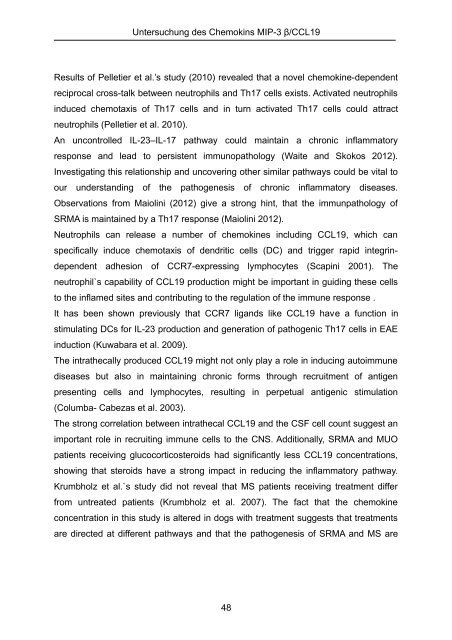TiHo Bibliothek elib - Tierärztliche Hochschule Hannover
TiHo Bibliothek elib - Tierärztliche Hochschule Hannover
TiHo Bibliothek elib - Tierärztliche Hochschule Hannover
Create successful ePaper yourself
Turn your PDF publications into a flip-book with our unique Google optimized e-Paper software.
Untersuchung des Chemokins MIP-3 β/CCL19<br />
Results of Pelletier et al.’s study (2010) revealed that a novel chemokine-dependent<br />
reciprocal cross-talk between neutrophils and Th17 cells exists. Activated neutrophils<br />
induced chemotaxis of Th17 cells and in turn activated Th17 cells could attract<br />
neutrophils (Pelletier et al. 2010).<br />
An uncontrolled IL-23–IL-17 pathway could maintain a chronic inflammatory<br />
response and lead to persistent immunopathology (Waite and Skokos 2012).<br />
Investigating this relationship and uncovering other similar pathways could be vital to<br />
our understanding of the pathogenesis of chronic inflammatory diseases.<br />
Observations from Maiolini (2012) give a strong hint, that the immunpathology of<br />
SRMA is maintained by a Th17 response (Maiolini 2012).<br />
Neutrophils can release a number of chemokines including CCL19, which can<br />
specifically induce chemotaxis of dendritic cells (DC) and trigger rapid integrindependent<br />
adhesion of CCR7-expressing lymphocytes (Scapini 2001). The<br />
neutrophil`s capability of CCL19 production might be important in guiding these cells<br />
to the inflamed sites and contributing to the regulation of the immune response .<br />
It has been shown previously that CCR7 ligands like CCL19 have a function in<br />
stimulating DCs for IL-23 production and generation of pathogenic Th17 cells in EAE<br />
induction (Kuwabara et al. 2009).<br />
The intrathecally produced CCL19 might not only play a role in inducing autoimmune<br />
diseases but also in maintaining chronic forms through recruitment of antigen<br />
presenting cells and lymphocytes, resulting in perpetual antigenic stimulation<br />
(Columba- Cabezas et al. 2003).<br />
The strong correlation between intrathecal CCL19 and the CSF cell count suggest an<br />
important role in recruiting immune cells to the CNS. Additionally, SRMA and MUO<br />
patients receiving glucocorticosteroids had significantly less CCL19 concentrations,<br />
showing that steroids have a strong impact in reducing the inflammatory pathway.<br />
Krumbholz et al.`s study did not reveal that MS patients receiving treatment differ<br />
from untreated patients (Krumbholz et al. 2007). The fact that the chemokine<br />
concentration in this study is altered in dogs with treatment suggests that treatments<br />
are directed at different pathways and that the pathogenesis of SRMA and MS are<br />
48










![Tmnsudation.] - TiHo Bibliothek elib](https://img.yumpu.com/23369022/1/174x260/tmnsudation-tiho-bibliothek-elib.jpg?quality=85)





